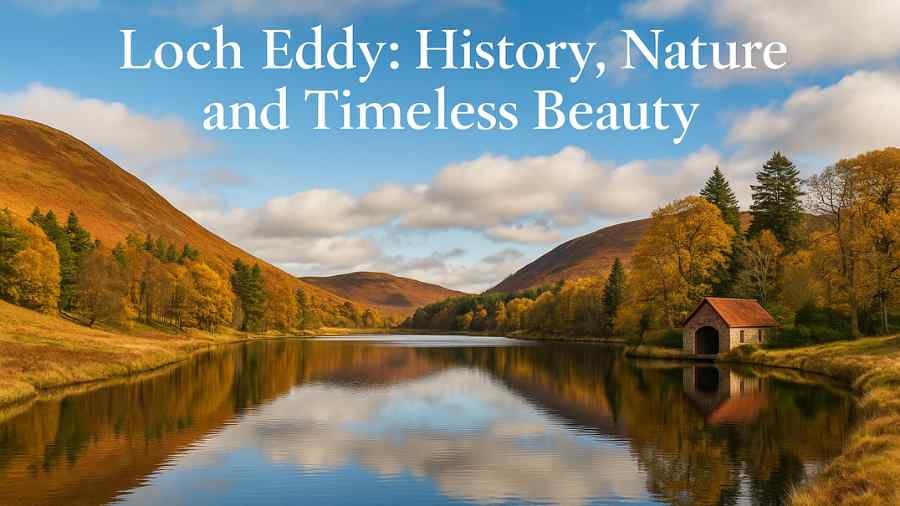Loch Eddy: A Hidden Scottish Treasure of History, Nature, and Timeless Beauty

Loch Eddy is one of the Scottish Borders’ most serene and enchanting landscapes, tucked away within the quiet folds of a private valley. Although it is less well-known than the great Highland lochs, Loch Eddy possesses a unique charm that blends history, natural beauty, artistic landscaping, and an atmosphere of complete tranquillity.
The Origins of Loch Eddy
Unlike many of Scotland’s natural lochs formed by glacial action, Loch Eddy has an artificial origin. It was created in the late nineteenth century as part of a broader vision to enhance the landscape around the Glen Estate, near Traquair in the Scottish Borders. During this period, estate owners often shaped their surroundings to reflect Victorian tastes for picturesque scenery, water features, and naturalistic design.
Despite being man-made, Loch Eddy blends seamlessly with the surrounding hills, forests, and valleys. Over more than a century, it has matured into a thriving natural environment, full of wildlife, vegetation, and ecological balance. It is now difficult for visitors to imagine that this tranquil loch is not an ancient feature sculpted by nature itself.
The Meaning Behind the Name
The name “Eddy” is widely believed to honour Edward Wyndham Tennant, a promising young poet and member of the Tennant family connected to the estate. Edward, affectionately known as “Bim”, was killed in the First World War during the Battle of the Somme. Although the loch predates his death, its long association with the Tennant family has given the name a deeper emotional resonance. Today, the name Loch Eddy symbolises remembrance, heritage, and a connection between land and lineage.
Geographical Setting
Loch Eddy sits in a picturesque glen surrounded by rolling hills, woodland, and the peaceful flow of nearby burns. The surrounding landscapes belong to the Glen Estate, a historic area characterised by traditional stone buildings, farmland, forested slopes, and rich wildlife habitats. The estate itself has a long history with architectural and cultural significance, and the loch forms part of its scenic heart.
The loch is relatively small compared to the major Scottish lochs, but its intimate scale adds to its charm. It is framed by grassy banks, heather-touched slopes, and clusters of trees that provide shade and wind protection. The reflections of the hills and sky in the calm water create a sense of stillness that many larger bodies of water cannot offer.
Natural Beauty and Atmosphere
Loch Eddy’s primary appeal lies in its serene atmosphere. It is a place where the modern world feels far removed, and the sounds of nature dominate the air. The gentle rustle of leaves, the call of birds, and the soft lapping of water against the edges of the loch create an ambience ideal for relaxation and quiet reflection.
The colours change dramatically throughout the year. In spring, fresh green leaves and wildflowers brighten the glen. Summer brings fuller vegetation that frames the loch with lush vibrancy. Autumn is perhaps the most breathtaking season, with gold, amber, and russet tones reflecting brilliantly on the water’s surface. Winter transforms the area into a calm, frost-covered landscape, offering a sense of peaceful isolation.
Wildlife Around the Loch
The combination of water, woodland, open glen, and hillside makes Loch Eddy a haven for wildlife. Birds commonly spotted in the area include herons, ducks, owls, and various songbirds. The surrounding forests may host red squirrels, deer, foxes, and a range of smaller mammals. Amphibians and insects thrive near the water’s edge, contributing to a balanced ecosystem.
The loch also attracts visitors who appreciate the opportunity to observe animals in their natural habitat. The tranquility of the environment ensures wildlife remains relatively undisturbed, making sightings common for patient observers and nature enthusiasts.
Walking Routes and Outdoor Recreation
One of the most popular ways to explore Loch Eddy is through the well-known circular walking route that guides visitors through the surrounding glen before descending towards the loch itself. The path includes sections of woodland, open countryside, and estate tracks, offering a rich variety of scenery along the way.
The final descent to the loch is often described as the most atmospheric part of the walk, as the trees open up and the water comes into view. Many walkers pause at the historic boathouse, an iconic feature that adds to the loch’s charm and photographic appeal.
While the walk is generally considered moderate, some areas can be muddy or uneven, particularly during or after rain. Sensible walking shoes or boots are recommended. The overall experience is rewarding for casual walkers, nature lovers, and those seeking a peaceful escape from busier outdoor destinations.
Cultural and Historical Significance
Beyond its scenic beauty, Loch Eddy forms part of the heritage of the Glen Estate, which has long been associated with prominent families, local history, and cultural development in the region. The estate’s architecture, landscaped grounds, and historical links reflect centuries of Scottish history.
Visitors often feel a deeper sense of connection when knowing that the area has hosted notable figures in British social and political life. The loch has served as a quiet retreat for generations of estate residents and guests. Although modest in size, it carries a depth of cultural memory that enriches its natural appeal.
The Role of Landscape Architecture
Loch Eddy is a fine example of Victorian landscape design. During the nineteenth century, many estate owners sought to reshape natural settings in ways that amplified beauty while maintaining an illusion of wildness. This approach involved creating water features, planting carefully selected tree species, and shaping pathways that guided visitors through pleasing views.
The loch feels perfectly placed within its glen, demonstrating how thoughtful design can complement natural features rather than overpower them. The result is a harmonious blend of human influence and natural growth, sustained over decades of gentle evolution.
Photography and Aesthetic Appeal
For photographers, Loch Eddy offers outstanding opportunities for capturing natural beauty. The quiet surface of the water often produces mirror-like reflections of the hills and sky. The boathouse adds a charming focal point, especially in soft morning or evening light.
Each season brings its own character, from misty, atmospheric mornings in autumn to crisp, snow-touched scenes in winter. The loch’s scale allows photographers to experiment with composition without the overwhelming vastness of larger Scottish landscapes.
Best Time to Visit
Although Loch Eddy can be enjoyed year-round, the best time to visit depends on the type of experience one seeks.
- Spring offers mild weather, blooming flora, and vibrant greens.
- Summer provides warm temperatures and fuller landscapes.
- Autumn is ideal for dramatic colours and scenic photography.
- Winter appeals to those who enjoy solitude, stillness, and a quiet retreat wrapped in cold beauty.
The Scottish Borders weather can be unpredictable at any time of year, so visitors should come prepared for changing conditions.
Practical Considerations for Visitors
Because the loch is located on private estate land, visitors should follow local access guidelines and respect the environment. Staying on marked paths, avoiding disturbance to wildlife, and taking all litter away are essential aspects of responsible exploration.
Parking in the area is limited, so careful planning is beneficial. Those visiting as part of a group often use car-sharing to minimise congestion near the estate’s entrance.
Why Loch Eddy Is Worth Discovering
Loch Eddy stands out not through grandeur but through subtle beauty, historical depth, and an atmosphere that invites reflection. It offers a blend of cultural heritage, natural charm, and peaceful surroundings that appeal to walkers, nature enthusiasts, photographers, and anyone seeking a quiet escape.
Its understated character is precisely what makes it special. In a world where many destinations are crowded or heavily commercialised, Loch Eddy provides a refreshing reminder of the enduring simplicity and serenity of the Scottish landscape.
Conclusion
Loch Eddy is a deeply charming destination that blends history, nature, and quiet beauty in a uniquely compelling way. Its combination of Victorian landscape design, cultural significance, wildlife, and peaceful atmosphere makes it a hidden treasure within the Scottish Borders. Whether visited for a leisurely walk, a moment of reflection, or an appreciation of its scenic surroundings, Loch Eddy stands as a timeless example of the harmonious connection between land, memory, and tranquillity.



